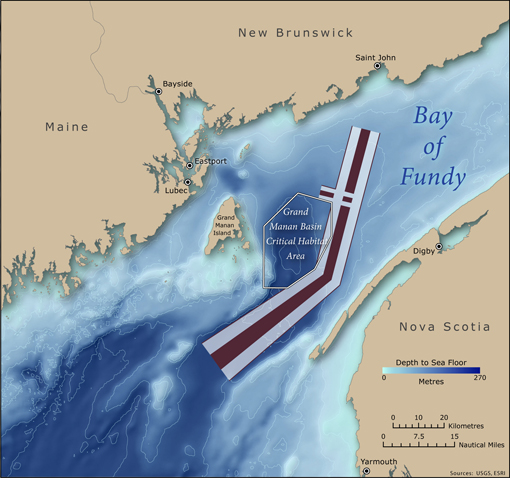


The Bay of Fundy, located between New Brunswick and Nova Scotia, is renowned for some of the highest tides in the world. In 1980, North Atlantic right whales were found in the Grand Manan Basin region when the New England Aquarium researchers were contracted to assess the marine mammal distribution and abundance in the Bay of Fundy as part of an environmental impact study related to a proposed oil refinery in Eastport, Maine. That year, 26 right whales were sighted, including 4 mother and calf pairs. The refinery was never constructed and the New England Aquarium has returned every August and September for the past 28 years to survey the Bay of Fundy for right whales. The historical use of the Bay of Fundy by right whales prior to 1980 is not well known, however there were sightings in the Bay of Fundy dating from mid 1960s 1, 2, 3, 4, and historical records from the 18th century 5.

The Grand Manan Basin Conservation Area is an important nursery ground for mother and calf pair right whales.
The lower Bay of Fundy is recognized as one of the five seasonally important right whale habitats along the Canadian and American seaboard. The area’s highest right whale concentration is the Grand Manan Basin, declared a conservation area by the Canadian government in 1993. From 2000 to 2005 between 62% and 87% of the total number of annual right whale identifications were made in the Bay of Fundy.
Right whale calf playing with seaweed in the
Bay of Fundy.
In addition to the numerous sightings, the Bay of Fundy is also the only known summer and fall nursery area for right whales in Canadian waters.
The Grand Manan Basin Conservation Area in the lower Bay of Fundy is a key habitat for the right whale's recovery. The Bay's strong tidal currents concentrate large quantities of zooplankton (copepods) into patches on which right whales, including mother and calf pairs, feed. Potential hazards to right whales in the Bay of Fundy include vessel strikes and entanglement in fishing gear. Two stewardship actions have been taken to protect right whales in this region: the designation of the conservation area and the relocation of the Bay of Fundy Traffic Separation Scheme. In addition, since 1997, whale watch companies who watch right whales are encouraged to abide by a voluntary Code of Ethics for Tour Operators. Fisheries and Oceans Canada have also been working toward the development of whale watching regulations to replace the current whale watch guidelines. In 2007, fishermen will be encouraged to abide by a voluntary Code of Conduct for Fisherman.

1 Schevill, W. E. 1968. Sight records of Phocoena phocoena and cetaceans in general. Journal of Mammalogy 49:794-796.
2 Arnold, P. W., and D. E. Gaskin. 1972. Sight records of right whales (Eubalaena glacialis) and finback whales (Balaenoptera physalus) from the lower Bay of Fundy. Journal of the Fisheries Research Board Canada 29:1477-1478.
3 Gaskin, D. E. 1991. An update on the status of the right whale, Eubalaena glacialis, in Canada. Canadian Field Naturalist 105:198-205.
4 Hay, K. A. 1980. COSEWIC status report on the right whale Eubalaena glacialis in Canada. Committee on the Status of Endangered Wildlife in Canada. Ottawa. 12 pages.
5 Reeves, R. R., and M. F. Barto. 1985. Whaling in the Bay of Fundy. Whalewatcher 19(4):14-18.

